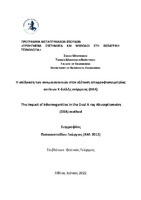| dc.contributor.advisor | Φούντος, Γεώργιος | |
| dc.contributor.author | Παπαευσταθίου, Γεώργιος | |
| dc.date.accessioned | 2022-07-04T15:12:33Z | |
| dc.date.available | 2022-07-04T15:12:33Z | |
| dc.date.issued | 2022-07-04 | |
| dc.identifier.uri | https://polynoe.lib.uniwa.gr/xmlui/handle/11400/2394 | |
| dc.identifier.uri | http://dx.doi.org/10.26265/polynoe-2235 | |
| dc.description.abstract | Η μέθοδος DXA θεωρείται η κύρια μέθοδος για τη μέτρηση της οστικής πυκνότητας (BMD) και μια αξιόπιστη μέθοδος για την εκτίμηση της σύστασης μάζας του ανθρώπινου σώματος. Ο προσδιορισμός των παραπάνω πραγματοποιείται μέσω του υπολογισμού της εξασθένησης της ακτινοβολίας δύο δεσμών ακτινοβολίας διαφορετικών ενεργειών που παράγονται από την πηγή ακτίνων Χ και καταγράφονται από το σύστημα ανίχνευσης. Στην παρούσα μελέτη εξετάζεται η επίδραση ανομοιογενειών, όπως το λίπος και το κολλαγόνο, που μπορεί να υπάρχουν στο ανθρώπινο σώμα και ο τρόπος που επηρεάζουν τους αλγόριθμους και το τελικό αποτέλεσμα του τεστ DXA. Αυτή η μελέτη πραγματοποιήθηκε στο πρόπλασμα (phantom) της σπονδυλικής στήλης του συστήματος DXA. Οι μετρήσεις BMD πραγματοποιήθηκαν χρησιμοποιώντας το μοντέλο DXA “Hologic Discovery QDR’’ με το phantom να ακτινοβολείται παρουσία των παραγόντων ανομοιογένειας (λίπος), όντας εμβαπτισμένο σε νερό. Οι τιμές BMD που ελήφθησαν παρουσία λίπους συγκρίθηκαν στη συνέχεια με τις τιμές BMD που ελήφθησαν μετρώντας το πρόπλασμα σπονδυλικής στήλης με την κανονική διαδικασία (στον αέρα). Η μέση τιμή BMD που μετρήθηκε σε συνθήκες ατμοσφαιρικού αέρα ήταν 0,97 gr/cm2 ενώ όταν το phantom εμβαπτίστηκε σε νερό ήταν 0,94 gr/cm2 παρουσιάζοντας στατιστικά σημαντική διαφορά (p<0,01). Παρουσία ανομοιογενειών (χοιρινό λίπος) οι τιμές BMD που βρέθηκαν κυμαίνονταν από 0,91 gr/cm2 έως 0,99 gr/cm2 ανάλογα με την τοποθέτηση. | el |
| dc.format.extent | 55 | el |
| dc.publisher | Πανεπιστήμιο Δυτικής Αττικής | el |
| dc.rights | Αναφορά Δημιουργού - Μη Εμπορική Χρήση - Παρόμοια Διανομή 4.0 Διεθνές | * |
| dc.rights.uri | https://creativecommons.org/licenses/by-nc-sa/4.0/deed.el | * |
| dc.subject | Οστική πυκνομετρία | el |
| dc.subject | Πρόπλασμα σπονδυλικής στήλης | el |
| dc.subject | Οστεοπόρωση | el |
| dc.subject | DXA | el |
| dc.subject | Osteoporosis | el |
| dc.subject | Inhomogenities | el |
| dc.subject | Bone mineral density | el |
| dc.title | H επίδραση των ανομοιογενειών στην εξέταση απορροφησιομετρίας ακτίνων Χ διπλής ενέργειας (DXA) | el |
| dc.title.alternative | The impact of inhomogenities in the Dual X-ray Absorptiometry (DXA) method | el |
| dc.type | Μεταπτυχιακή διπλωματική εργασία | el |
| dc.contributor.committee | Kalyvas, Nektarios | |
| dc.contributor.committee | Βαλαής, Ιωάννης | |
| dc.contributor.faculty | Σχολή Μηχανικών | el |
| dc.contributor.department | Τμήμα Μηχανικών Βιοϊατρικής | el |
| dc.contributor.master | Προηγμένα Συστήματα & Μέθοδοι στη Βιοϊατρική Τεχνολογία | el |
| dc.description.abstracttranslated | The DXA method is considered as the standard method for measuring bone mineral density (BMD) and a reliable method for estimating the mass composition of the human body. The determination of the above is obtained by measuring the radiation attenuation of two beams of different energies produced by the x-ray source of proper filtering, and recorded by the detector system. In the present study, the effect of inhomogenities, such as fat and collagen, that may exist in the human body and the way they affect the algorithms and the final result of the DXA test, are examined. This study was performed in the spine model phantom of the DXA system. BMD measurements were performed with the phantom and inhomogenities (fat), immerged in water bath, using the DXA model “Hologic Discovery QDR”. The BMD values obtained in the presence of fat were then compared with the BMD values obtained by measuring the phantom with the normal procedure. The mean BMD value measured with the normal procedure was 0.97 gr/cm2 while when the phantom was immerged in water bath was 0.94 gr/cm2 showing statistical significant difference (p<0.01). In the presence of inhomogenities (pork fat) the BMD values found ranged from 0.91 gr/cm2 to 0.99 gr/cm2 depending on the positioning. | el |


